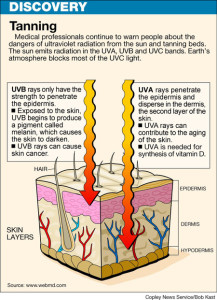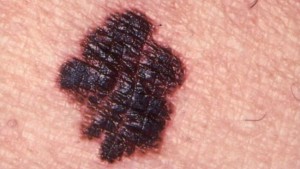Why Write About This?
At first this topic may seem a little strange for the Science 200 blog. After all, it is not particularly controversial and the data all seems to support one easy conclusion. So why write it all? The answer to that for me is simple. Because people need to know. As you all cruise along the course website looking for things to comment on, this blog might catch your attention. Maybe you learn something new about tanning, maybe it finally convinces you to stop an unhealthy cycle of damage. Whatever may happen, at least you are now a well-informed consumer.
There are many reasons that people give for tanning. “I want to look good.” “Vitamin D is important.” “It keeps me from getting sunburned.” Clearly there are reasons that tanning is so popular. So I decided to so a little research about the benefits and harms of tanning.
Why is it Popular?
Tanning wasn’t always as popular as it is today. In fact, legend has it that tanning really came into style when well-known fashion designer Coco Chanel came back from a Mediterranean vacation with a newly golden skin tone. That glow was unattainable to the average person for many years until the invention of the tanning bed. As each year passed, tanning became more and more in vogue until the image of the perfect American girl had changed. No longer was your average teenager paler in the winter than the summer. Peer pressure and changing beauty standards urged girls to go the tanning bed as quickly as possible. Today, 1 out of 3 white high school girls has reported using indoor tanning. This could stem from misconceptions about the benefits of tanning which is partially encouraged by the tanning industry itself.
Vitamin D
Many people argue that the benefit of Vitamin D received by tanning outweigh the possible negative effects. According to “Indoor Ultraviolet Tanning and Skin Cancer: Health Risks and Opportunities,” Vitamin D from tanning is beneficial to the body. So what’s the catch? While it is true that tanning gives your body Vitamin D, it also causes DNA damage. It’s also important to note that tanning is not the only source of Vitamin D, but is a dangerous one. If you feel as though you’re lacking in Vitamin D, take a supplement or drink some milk.
Base Tans and “Healthy” Glow
Tan skin = damaged skin. Actually, the way tanning works is that if you have a tan, you have DNA damage. No ifs, ands, or, buts about it. The process of tanning begins with damaged DNA. While you can have DNA damage without a tan, the process does not work in reverse. Many people think that a “base tan,” can protect you from further sunburn and damage to the skin. Unfortunately that statement is only partially true. “Does a Base Tan Protect From Future Burns or Give a False Sense of Security?” says that having a base tan can give you protection equivalent to about 4 SPF, but that in on order to get a base tan, you are increasing your risk of skin cancer. The same study point out that those people who tan before age 35 have a 75% greater chance of getting melanoma than those who do not. People can feel pressured to be tan, but with every tan you are putting yourself deeper into a hole that you can’t get back out of. According to this study conducted by the U.S National Library of Medicine and the National Institute of Health, for every use of a tanning bed, the risk of melanoma goes up 1.8%. Perhaps a more important fact for tanners is
Tanning: The Cigarette Problem of Today’s Girls
Think back to the cigarette problem we discussed in class at the beginning of the year. Remember how people weren’t aware of the harmful effects of smoking? The delay in the amount of time it took from the actual event to the negative aftermath made it hard to prove a casual relationship. With tanning, the relationship has already been found and supported by several meta-analyses. So why is it still legal and relatively unregulated? The answer can once again be found in money. Billions of dollars are spent every year on tanning and according to this examination of tanning literature, in 166 large cities in the United States, tanning facilities are more common than Starbucks or McDonalds. Every year more and more people begin tanning, especially adolescents. Here’s what makes tanning even more dangerous than cigarettes: The amount of times it takes to do damage. While I don’t recommend doing it, you’re probably not going to get lung cancer from smoking one cigarette a year, but with only a few tanning sessions, you can drastically increase your risk of melanoma. The other thing that makes tanning so dangerous is its innocent appearing nature. More girls have done indoor tanning than have smoked cigarettes according to this New York Times article. Quite simply put, that means that tanning is a problem.
Another similarity between cigarettes and tanning can be found in the amount of misinformation that is communicated. Take a look at the chart to the right from “Indoor Tanning, Skin Cancer and the Young Female Patient: A Review of the Literature” about information given by tanning salons to agents posing as young, fair, females. 90% of the tanning salons contacted said there was no risk to tanning. The evidence supporeted by multiple meta-analyses has shown that this is simply not true. Everytime you tan you are damaging your DNA and increasing your risk of skin cancer. Like cigarettes, an extremely dangerous pastime is being sugarcoated and misinformed young ladies are sacrificing their skin for it.
What Should be Done?
In my opinion, the reprecussions from indoor tanning are severe enough that the practice should be outlawed. Brazil has done it and so has most of Australia. Many states have laws preventing minors from tanning, but why not ban it all together? When you tan, you are literally baking yourself in an oven, increasing your risk of deadly skin cancer dramatically, and paying for the privilege of doing so. I know that this is not a popular opinion to have, and that many risk takers will read this and ignore it, but ask yourself this, “Do I want to be around when my kids are growing up? Am I willing to potentially sacrifice my future for a tan that will fade in a month anyway?” Some of you may argue that not everyone who tans will get skin cancer, and that is a true statement. But are you willing to play those odds?
Conclusion:
Tanning simply isn’t worth the risk. That’s not to say that there aren’t some benefits, like production of Vitamin D, but the benefit isn’t worth the risk. In my opinion, stronger legislation or an outright ban is necessary to stop thousands of preventable deaths from occurring. Tanning is not a need, merely a cosmetic device that should be stopped immediately, before more people die.
How do you feel about tanning and its legality? Should the CDC ban it for the general public health? Is it a good method for population control? Do you adamantly disagree with my conclusion? Let me know in the comments below. If you are still looking for some more blogs to comment on, then check out my blog series on the moon.
That’s all for now.
Meghan




Amp6199,
Unfortunately I have to disagree with you about people staying away from tanning beds. Some people are misled by the information provided to them by tanning salons and continue to tan despite the facts. To me it seems outrageous that someone would knowingly put themselves in that sort of danger for a cosmetic purpose, but people still do. Because of this, I think that tanning should be banned. I have several good friends who are aware of the information provided in this blog and will do nothing to change their habits. That’s bad for both me and their families, because we both would like to keep them around for a while.
This is an incredibly thorough blog. I’ve always found tanning a little absurd- being tan a hundred years ago was a sign of poverty and told everyone that you’d been laboring all day in the fields doing hard work. Being pale back then was a sign that you could stay inside all day, socialize, manage business affairs, are were wealthy enough to afford protection from the sun’s rays. Now, being tan is a sign of wealth and being able to afford a vacation to a tropical resort. I don’t think that wealth should have a role in what is considered beautiful or not- I’ve seen a lot of really gorgeous girls with ivory skin and a lot of fake looking girls with carrot-orange spray tans. I guess Im just trying to say that regarding tanning, do what you want, but I don’t think anyone should have to change their skin tone to be considered more attractive. If you’re thinking of getting a fake tan to conform to societal trends, just remember- everyone in the 1800s would’ve died to have your complexion!
I’m so glad someone decided to make a blog post about this. My family is incredibly Irish, and I have very fair skin myself. You do mention that people do not know the long term effects of tanning beds, but I think we already know the effects of overexposure to the sun, and for most, that should be enough to convince them to keep away from tanning beds. Let me elaborate: my dad, who is in his mid-60s now, did not wear sunscreen growing up, as was custom back then. Now, he has a form of DNA damage called basal cell cancer. Thankfully, it is not melanoma, the most serious form of skin cancer, but it is not pretty. At least 3 times a year, my dad has to go to the dermatologist and get growths (like the one you have pictured above) burned off of his face, shoulders and back. I have seen the effects of “tanning” first hand, and it is horrifying. However, I know I am biased and basing my opinions off of my personal experience, which Andrew says we should try to avoid. So, here is a chart of people that already have skin cancer. As you can see, white people suffer the most, so why increase your risk by going under a tanning bed? It absolutely breaks my heart that people think tanning beds are OK, and I hope something is done to promote a change soon.